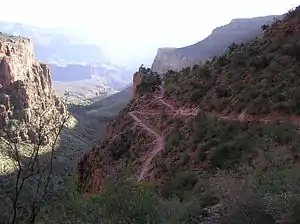Bright Angel (Waterhouse)
Bright Angel is a composition for three bassoons and contrabassoon by Graham Waterhouse. It was composed in 2008 for the annual conference of the International Double Reed Society.
| Bright Angel | |
|---|---|
| Quartet for Bassoons by Graham Waterhouse | |
 Bright Angel Trail of the Grand Canyon, inspiration for the composition | |
| Year | 2008 |
| Period | contemporary |
| Published | 2009: Warngau Accolade |
| Movements | 3 |
| Scoring | |
History
Graham Waterhouse composed Bright Angel for the IDRS Conference 2008 in Provo, Utah, and chose the theme of the composition to match the setting of the conference. He recalls a hike which he took, age nine, with his father William Waterhouse. In 1972, when the bassoonist taught for one year at Indiana University, they crossed the Grand Canyon from the North Rim to the South Rim, on the North Kaibab Trail and the Bright Angel Trail.[1][2]
Bright Angel was premiered by Michel Bettez, Richard Ramey,[3] Richard Moore and Henry Skolnick, conducted by the composer, at the Brigham Young University. It was published by the German publisher Accolade (Warngau) in 2009 as Bright Angel für 3 Fagotte und Kontrafagott.[4]
Bright Angel was part of a concert The Proud Bassoon, celebrating William Waterhouse on 16 April 2011 in Wigmore Hall. It was performed by the Bassoon Quartet from the Royal Northern College of Music in Manchester, where William Waterhouse had been a teacher of bassoon and a curator of the instrument collection.[5] The players were James Thomas, Linda Begbie and Stefano Canuti, bassoon, and Jonathan Jones, contrabassoon, lead by Canuti who is "International Chair in Bassoon" at the RNCM, and Professor at the Conservatorio Superior de Aragon.[6] The performance was the premiere of Bright Angel in the United Kingdom.[7] The composer's string trio Epitaphium, originally composed for his father's memorial service, was also part of the concert program.[8]
Music
The composer comments:
The piece tries to reflect a sense of wonder and awe at both the majesty and the brutality of Nature. Some of the contours (or recollections of them) are mirrored in the variously undulating and jagged lines. Also recalled during the composition were the perpetually shifting vistas, as well as the toil of tramping out the dusty trail, stumbling over boulders, cowering during a storm. The musical material is mostly contained within the opening motive, first heard as a solitary voice, before recurring over a wide-spanning accompaniment of arpeggios. The slow, reflective introduction gives way to a faster section, based on an energetic, pulsating rhythm. It is to the tranquil mood of the opening that the work eventually returns, closing on an unresolved chord, to capture the eternity of the Canyon.[1]
After the concert in Wigmore Hall, the reviewer described an arch between a "deep, grumbling opening and ending (rather like Richard Strauss’s An Alpine Symphony)" and the "various moods of the route in an engagingly atmospheric piece".[8]
References
- "Bright Angel". Graham Waterhouse. 2011. Retrieved 20 April 2011.
- "Bright Angel(Sc&Pts)-3BSN/CBSN". trevcomusic.com. 2011. Archived from the original on 16 March 2012. Retrieved 20 April 2011.
- "Richard Ramey / bassoon". University of Arkansas. 2011. Retrieved 20 April 2011.
- "Waterhouse, Graham / Bright Angel für 3 Fagotte und Kontrafagott (Partitur & Stimmen)". Accolade. 2011. Archived from the original on 3 September 2011. Retrieved 20 April 2011.
- "William Waterhouse Memorial Concert / The Proud Bassoon". Wigmore Hall. 2011. Archived from the original on 28 July 2011. Retrieved 20 April 2011.
- "William Waterhouse Celebration / The Proud Bassoon" (PDF). Park Lane Group. 2011. Retrieved 20 April 2011.
- "Interesting upcoming performances" (PDF). The Double Reed (Quarterly Journal). IDRS: 34. 2010. Archived from the original (PDF) on 11 May 2011. Retrieved 20 April 2011.
- Breckenfield, Nick (18 April 2011). "William Waterhouse Memorial Concert at Wigmore Hall". classicalsource.com. Retrieved 20 April 2011.